Pentagram
| Regular pentagram | |
|---|---|
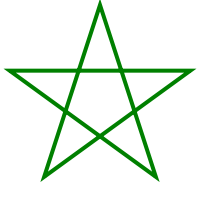 A pentagram |
|
| Type | Star polygon |
| Edges and vertices | 5 |
| Schläfli symbol | {5/2} |
| Coxeter–Dynkin diagram | |
| Symmetry group | D5 (Order 10) |
| Internal angle (degrees) |
36° |
A pentagram (sometimes known as a pentalpha or pentangle or, more formally, as a star pentagon) is the shape of a five-pointed star drawn with five straight strokes. The word pentagram comes from the Greek word πεντάγραμμον (pentagrammon), a noun form of πεντάγραμμος (pentagrammos) or πεντέγραμμος (pentegrammos), a word meaning roughly "five-lined" or "five lines".
Pentagrams were used symbolically in ancient Greece and Babylonia, and are used today as a symbol of faith by many Wiccans, akin to the use of the cross by Christians and the Star of David by Jews. The pentagram has magical associations, and many people who practice Neopagan faiths wear jewelry incorporating the symbol. Christians once more commonly used the pentagram to represent the five wounds of Jesus.[1][2] The pentagram has associations with Freemasonry[3] and is also utilized by a number of other belief systems.
The word "pentacle" is sometimes used synonymously with "pentagram", and this usage is borne out by the Oxford English Dictionary, although that work specifies that a circumscription makes the shape more particularly a pentacle.[4] Wiccans and Neo-pagans often make use of this more specific definition for a pentagram enclosed in a circle.[5]
Contents |
Symbolic Meaning
The circle around a pentagram (transforming it in to a pentacle,) is a symbol of "unity, wholeness, infinity, the goddess, and protection. To earth-centered religions throughout history as well as to many contemporary pagans, it represents the feminine spirit or force, the cosmos or a spiritualized Mother Earth, and a sacred space." The five-pointed star is representative of the four primal elements (earth, air, fire and water,) and traditionally a fifth, called spirit. The circle binds them together to create life. When pointing up, the pentagram can represent spirituality's dominance over the material (pentagram) bound inside the laws of the cosmos (circle). The upside-down facing pentagram, meanwhile, represents the physical world ruling over the spiritual, and has therefore been associated with dark magic. Other sources point to its origin in Chinese five-element philosophy (see feng shui), as the natural balance between fire, water, earth, wood, and metal. This theory states that the direction it is pointing has nothing to do with good or evil, but rather the upside-down facing circle is for banishing. The circle is again for the concept the power within is bound by, this time for the circle of life.[6]
Early history
Sumer
The first known uses of the pentagram are found in Mesopotamian writings dating to about 3000 BC. The Sumerian pentagrams served as pictograms for the word "UB" meaning "corner, angle, nook; a small room, cavity, hole; pitfall," suggesting something very similar to the pentemychos (see below on the Pythagorean use for what pentemychos means). In René Labat's index system of Sumerian hieroglyphs/pictograms it is shown with two points up.[7] In the Babylonian context, the edges of the pentagram were probably orientations: forward, backward, left, right, and "above".[8] These directions also had an astrological meaning, representing the five planets Jupiter, Mercury, Mars and Saturn, and Venus as the "Queen of Heaven" (Ishtar) above.[8]
Pythagoreans
The Pythagoreans called the pentagram ὑγιεία Hygieia ("health"; also the Greek goddess of health, Hygieia), and saw in the pentagram a mathematical perfection (see Geometry section below).
The ancient Pythagorean pentagram was drawn with two points up and represented the doctrine of Pentemychos. Pentemychos means "five recesses" or "five chambers", also known as the pentagonas — the five-angle, and was the title of a work written by Pythagoras's teacher and friend Pherecydes of Syros.[9] It was also the "place" where the first pre-cosmic offspring had to be put in order for the ordered cosmos to appear.
European occultism
Heinrich Cornelius Agrippa and others perpetuated the popularity of the pentagram as a magic symbol, keeping the Pythagorean attributions of elements to the five points. By the mid-19th century a further distinction had developed amongst occultists regarding the pentagram's orientation. With a single point upwards it depicted spirit presiding over the four elements of matter, and was essentially "good". However, the influential writer Eliphas Levi called it evil whenever the symbol appeared the other way up.
- "A reversed pentagram, with two points projecting upwards, is a symbol of evil and attracts sinister forces because it overturns the proper order of things and demonstrates the triumph of matter over spirit. It is the goat of lust attacking the heavens with its horns, a sign execrated by initiates."[10]
- "The flaming star, which, when turned upside down, is the hierolgyphic [sic] sign of the goat of Black Magic, whose head may be drawn in the star, the two horns at the top, the ears to the right and left, the beard at the bottom. It is the sign of antagonism and fatality. It is the goat of lust attacking the heavens with its horns."[11]
- "Let us keep the figure of the Five-pointed Star always upright, with the topmost triangle pointing to heaven, for it is the seat of wisdom, and if the figure is reversed, perversion and evil will be the result."[12]
.jpg) Man inscribed in a pentagram, from Heinrich Cornelius Agrippa's De occulta philosophia libri tres. The five signs at the pentagram's vertices are astrological. |
Another pentagram from Agrippa's book. This one has the Pythagorean letters inscribed around the circle. |
.jpg) The occultist and magician Eliphas Levi's pentagram, which he considered to be a symbol of the microcosm, or human. |
Religious symbolism
Christianity
The pentagram is used as a Christian symbol for the five senses,[13] and if the letters S, A, L, V, and S are inscribed in the points, it can be taken as a symbol of health (from Latin salus).[14]
Medieval Christians believed that the "pentalpha" symbolises the five wounds of Christ. The pentagram was believed to protect against witches and demons.[15]
The pentagram figured in a heavily symbolic Arthurian romance:[15] it appears on the shield of Sir Gawain in the 14th century poem Sir Gawain and the Green Knight. As the poet explains, the five points of the star each have five meanings: they represent the five senses, the five fingers, the five wounds of Christ,[16] the five joys that Mary had of Jesus (the Annunciation, the Nativity, the Resurrection, the Ascension, and the Assumption), and the five virtues of knighthood which Gawain hopes to embody: noble generosity, fellowship, purity, courtesy, and compassion.
Most Christians came to associate it with Satanism and subsequently rejected the symbol sometime in the twentieth century.[15]
Mormonism
The Church of Jesus Christ of Latter-day Saints has used inverted five-pointed stars in Temple architecture, specifically the Nauvoo Illinois Temple,[17] the Salt Lake Temple, and the Logan Temple. These symbols derived from traditional Morning Star pentagrams that are no longer commonly used in mainstream Christianity.[18] Upright five-pointed stars also decorate several Latter-day Saint temples.
Neopaganism

Many Neopagans, especially Wiccans, use the pentagram as a symbol of faith similar to the Christian cross or the Jewish Star of David. It is not, however, a universal symbol for Neopaganism, and is rarely used by Reconstructionists. Its religious symbolism is commonly explained by reference to the neo-Pythagorean understanding that the five vertices of the pentagram represent the four elements with the addition of Spirit as the uppermost point. As a representation of the elements, the pentagram is involved in the Wiccan practice of summoning the elemental spirits of the four directions at the beginning of a ritual.
The outer circle of the circumscribed pentagram is sometimes interpreted as binding the elements together or bringing them into harmony with each other. The Neopagan pentagram is generally displayed with one point up, partly because of the "inverted" goat's head pentagram's association with Satanism; however, within traditional forms of Wicca a pentagram with two points up is associated with the Second Degree Initiation and in this context has no relation to Satanism.[19]
Because of a perceived association with Satanism and also because of negative societal attitudes towards Neopagan religions and the "occult", many United States schools have sought to prevent students from displaying the pentagram on clothing or jewelry.[20][21][22] In public schools, such actions by administrators have been determined to be in violation of students' First Amendment right to free exercise of religion.[23]
Satanism
.jpg)
Satanists use a pentagram with two points up, often inscribed in a double circle, with the head of a goat inside the pentagram. This is referred to as the Sigil of Baphomet. They use it much the same way as the Pythagoreans, as Tartaros literally translates from Greek as a "Pit" or "Void" in Christian terminology (the word is used as such in the Bible, referring to the place where the fallen angels are fettered). The Pythagorean Greek letters are most often replaced by the Hebrew letters לויתן forming the name Leviathan. Less esoteric LaVeyan Satanists use it as a sign of rebellion or religious identification, the three downward points symbolising rejection of the holy Trinity and the horns pointing up in defiance of conventional religious (spiritual) dogma.
Thelema
Aleister Crowley also made use of the pentagram and in his Thelemic system of magick: an adverse or inverted pentagram represents the descent of spirit into matter, according to the interpretation of Lon Milo DuQuette.[24] Crowley contradicted his old comrades in the Hermetic Order of the Golden Dawn, who following Levi considered this orientation of the symbol evil and associated it with the triumph of matter over spirit.
Bahá'í Faith
The five-pointed star is the official symbol of the Bahá'í Faith.[25] In the Bahá'í Faith, the star is known as the Haykal (Arabic: "temple"), and it was initiated and established by the Báb. Both the Báb and Bahá'u'lláh wrote various works in the form of a pentagram.[26]
 An unidentified work of the Báb. |
 An unidentified work of the Báb. |
Taoism
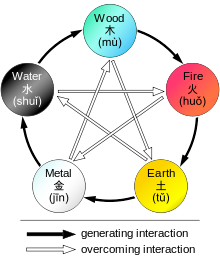
Taoism conceived of a five element system which governed the natural world which they called the Wu Xing (Chinese:五行/Wǔ Xíng). Unlike the Greek system of four elements being Earth, Air, Fire, and Water, the Chinese system involved Fire (火/huǒ), Earth (土/tǔ), Metal (金/jīn), Water (水/shuǐ), and Wood (木/mù). This five element system was normally depicted as a pentagram(Chinese:五星/Wǔ Xīng) ringed by a circle. The circle was used to describe the generative cycle where wood feeds fire, fire creates earth (ash), earth bears metal, metal carries water, and water nourishes wood. The pentagram describes the destructive or overcoming system where Wood parts Earth, Earth absorbs Water, Water quenches Fire, Fire melts Metal, Metal chops Wood, or the alternative destructive system: Wood absorbs Water, Water rusts Metal, Metal breaks up Earth, Earth smothers Fire, Fire burns Wood. This system informs traditional Chinese medicine (TCM) even today. As the Wu Xing is of great antiquity and the silk road had been open to Europe since before the Roman Empire it is quite likely that this medical system was imported to Europe as a misunderstood and exotic practice involving spirits (Shen).
Judaism
In Jewish tradition it is named Seal of Solomon.
Political symbolism
Flags
While a solid five-pointed star is found on many flags, the pentagram is relatively rare. It appears on two national flags, those of Ethiopia and Morocco and in some coats of arms.
According to Ivan Sache, on the Moroccan flags, the pentagram represents the link between God and the nation.[27] It is also possible that both flags use the pentagram as a symbol of King Solomon (see Seal of Solomon), the archetypal wise king of Jewish, Christian and Muslim lore, although the Star of David is a more common and more widely accepted symbol.
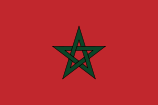 Morocco's flag |
 Ethiopia's flag |
Other organizations
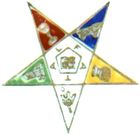
Order of the Eastern Star
The Order of the Eastern Star, a fraternal organization associated with Freemasonry, has employed a point-down pentagram as its symbol, with the five isosceles triangles of the points colored red, blue, yellow, white and green. This is an older form of the order's emblem and it is now more commonly depicted with the central pentagon rotated 36° so that it is no longer strictly a pentagram.
In literature
In the medieval romance of Sir Gawain and the Green Knight, the pentagram on Gawain's shield is given a Christian interpretation (see above).
In Goethe's Faust, the pentagram prevents Mephistopheles from leaving a room.
- Mephistopheles:
- I must confess, my stepping o'er
- Thy threshold a slight hindrance doth impede;
- The wizard-foot doth me retain.
- Faust:
- The pentagram thy peace doth mar?
- To me, thou son of hell, explain,
- How earnest thou in, if this thine exit bar?
- Could such a spirit aught ensnare?
According to Eliphas Levi, the sign of the pentagram is exalted by Goethe in the beautiful monologue of Faust:
"... Ah, how do all my senses leap at this sight! I feel the young and sacred pleasure of life quivering in my nerves and veins. Was it a God who traced this sign which stills the vertigo of my soul, fills my poor heart with joy, and, in a mysterious rapture, unveils the forces of Nature around me? Am I myself a God? All is so clear to me: I behold in these simple line the revelation of active Nature to my soul. I realise for the first time the truth of the wise man's words: The world of spirits is not closed! Thy sense is obtuse, thy heart is dead! Arise! Bathe, O adept of science, thy breast, still enveloped by an unearthly veil, in the splendours of the dawning day!" (Faust, Part i.sc.i).[28]
In H. P. Lovecraft's Cthulhu Mythos stories, the version of The Elder Sign devised by August Derleth is a warped pentagram with a flaming eye or pillar of flame in the center. It was first described in Derleth's novel, The Lurker at the Threshold. (This was, however, different from the symbol that Lovecraft himself had envisaged.)
In Dan Brown's novel The Da Vinci Code, the pentagram represents Venus, based on the successive inferior conjunctions of Venus against the Zodiac.
In Japanese culture, the pentagram (五芒星 gobōsei) is a symbol of magical power, associated with the onmyoji Abe no Seimei; it is a diagram of the "overcoming cycle" of the five Chinese elements. As a predominantly non-Christian country, with a different set of associations attached to the symbol, there is no social stigma associated with it.
Geometry
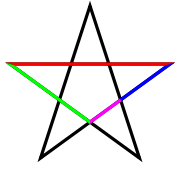
The pentagram is the simplest regular star polygon. The pentagram contains ten points (the five points of the star, and the five vertices of the inner pentagon) and fifteen line segments. It is represented by the Schläfli symbol {5/2}. Like a regular pentagon, and a regular pentagon with a pentagram constructed inside it, the regular pentagram has as its symmetry group the dihedral group of order 10.
Construction
The pentagram can be constructed by connecting alternate vertices of a pentagon; see details of the construction. It can also be constructed as a stellation of a pentagon, by extending the edges of a pentagon until the lines intersect.
Golden ratio
The golden ratio, φ = (1+√5)/2 ≈ 1.618, satisfying
plays an important role in regular pentagons and pentagrams. Each intersection of edges sections the edges in golden ratio: the ratio of the length of the edge to the longer segment is φ, as is the length of the longer segment to the shorter. Also, the ratio of the length of the shorter segment to the segment bounded by the 2 intersecting edges (a side of the pentagon in the pentagram's center) is φ. As the four-color illustration shows:
The pentagram includes ten isosceles triangles: five acute and five obtuse isosceles triangles. In all of them, the ratio of the longer side to the shorter side is φ. The acute triangles are golden triangles. The obtuse isosceles triangle highlighted via the colored lines in the illustration is a golden gnomon.
Trigonometric values
-
- See Exact trigonometric constants: Pentagon
As a result, in an isosceles triangle with one or two angles of 36°, the longer of the two side lengths is φ times that of the shorter of the two, both in the case of the acute as in the case of the obtuse triangle.
Three-dimensional figures
- See Uniform polyhedron: Icosahedral symmetry
Several polyhedra incorporate pentagrams:
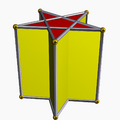 Pentagrammic prism |
 Pentagrammic antiprism |
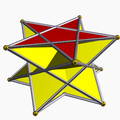 Pentagrammic crossed antiprism |
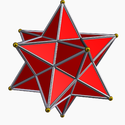 Small stellated dodecahedron |
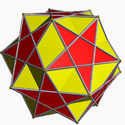 Small ditrigonal icosidodecahedron |
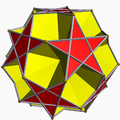 Small dodecahemicosahedron |
 Snub dodecadodecahedron |
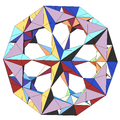 16th stellation of icosidodecahedron |
Higher dimensions
Orthogonal projections of higher dimensional polytopes can also create pentagrammic figures:
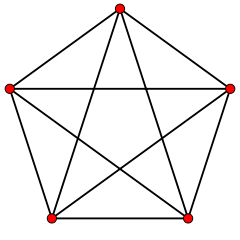 The regular 5-cell (4-simplex) has 5 vertices and 10 edges |
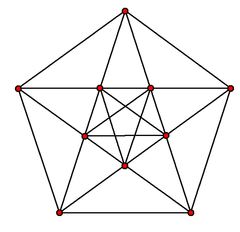 Rectified 5-cell has 10 vertices and 30 edges |
All ten 4-dimensional Schläfli-Hess polychoron have either pentagrammic faces or vertex figure elements.
In Astronomy and nature
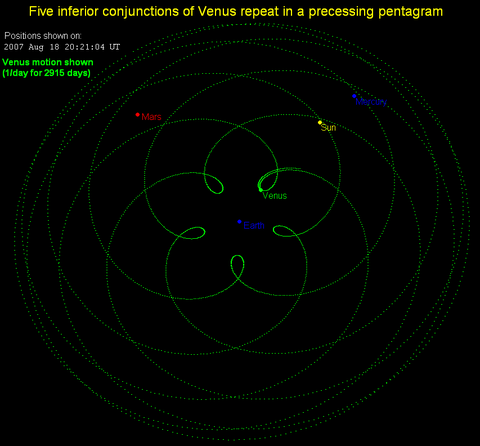 Successive inferior conjunctions of Venus repeat very near a 13:8 orbital resonance (The Earth orbits 8 times for every 13 orbits of Venus), creating a pentagrammic precession sequence. |
In visual arts
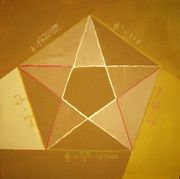
- The artist Martina Schettina uses pentagrams in her paintings.[29] The painting "Golden Pentagram" was shown at the Museumsquartier in Vienna in 2010.[30]
See also
- Bahá'í symbols
- Command-at-Sea Pin
- Enneagram (geometry)
- Heptagram
- Hexagram
- Nonconvex uniform polyhedra with full icosahedral symmetry (many show a pattern of pentagrams)
- List of regular polytopes#Two Dimensions 2
- List of symbols
- Mullet (heraldry)
- Pentad
- Pentachoron - the 4-simplex
- Petersen graph
- Ptolemy's theorem
- Red star
- Star (glyph)
- Stellated polygons
Notes
- ↑ "Pentagram" article in The Continuum Encyclopedia of Symbols Becker, Udo, ed., Garmer, Lance W. translator, New York: Continuum Books, 1994, p. 230.
- ↑ Signs and Symbols in Christian Art Ferguson, George, Oxford University Press: 1966, p. 59.
- ↑ Order of the Eastern Star
- ↑ "Pentacle", Oxford English Dictionary.
- ↑ Associated Press (2007-04-23). "Wiccan symbol OK for soldiers' graves". CNN.com. http://web.archive.org/web/20070426075801/http://www.cnn.com/2007/US/04/23/wiccan.grave.ap/index.html. Retrieved 2007-04-23.
- ↑ http://relijournal.com/paganism/the-true-meaning-of-the-pentacle/
- ↑ Labat, René. Manuel d'épigraphie akkadienne: Signes, Syllabaire, Idéogrammes. The pentagram is symbol number 306 in this system.
- ↑ 8.0 8.1 http://merlinravensong2.tripod.com/the-pentagram.html
- ↑ This is a lost book, but its contents are preserved in Damascius, De principiis, quoted in Kirk and Raven, The Pre-Socratic Philosophers, Cambridge Univ. Press, 1956, p. 55.
- ↑ Levi, Eliphas (1855). Transcendental Magic, its Doctrine and Ritual.
- ↑ Levi, Eliphas (1861, translated 2001 by Aleister Crowley). The Key of the Mysteries. Found at http://www.scribd.com/doc/9668236/The-Key-of-the-Mysteries-by-Levi, page 69.
- ↑ Hartmann, Franz (c. 1895). Magic, White and Black.
- ↑ Christian Symbols Ancient and Modern, Child, Heather and Dorothy Colles. New York: Charles Scribner's Sons, 1971, ISBN 0-7135-1960-6.
- ↑ http://www.mediade.si/media/symbolic.meaning.of.the.pentagram.extract.pdf
- ↑ 15.0 15.1 15.2 Pentagram, pentacle
- ↑ Christian Symbols and How To Use Them, Knapp, Justina; Milwaukee: The Bruce Publishing Company, 1955. Plate LXV, Plate LV (Imprimatur, Jos. F. Busch, Bishop of St. Cloud)
- ↑ See the Nauvoo Temple website discussing its architecture, and particularly the page on Nauvoo Temple exterior symbolism. Retrieved 13 December 2006.
- ↑ Brown, Matthew B (2002). "Inverted Stars on LDS Temples". FAIRLDS.org. Archived from the original on February 29, 2008. http://web.archive.org/web/20080229073604/http://www.fairlds.org/pubs/Stars.pdf.
- ↑ Stewart, Farrar. The Witches' Way.Chapter II - Second Degree Initiation
- ↑ "Religious Clothing in School", Robinson, B.A., Ontario Consultants on Religious Tolerance, 20 August 1999, updated 29 April 2005. accessed 10 February 2006.
- ↑ "ACLU Defends Honor Student Witch Pentacle" press release, American Civil Liberties Union of Michigan, 10 February 1999. accessed 10 February 2006.
- ↑ "Witches and wardrobes: Boy says he was suspended from school for wearing magical symbol" Rouvalis, Cristina; Pittsburgh Post-Gazette, September 27, 2000. accessed 10 February 2006.
- ↑ "Federal judge upholds Indiana students' right to wear Wiccan symbols". Associated Press. 1 May 2000. http://www.firstamendmentcenter.org//news.aspx?id=7234. Retrieved 2007-09-21.
- ↑ The Magick of Aleister Crowley p 93 and endnote 31 to Chapter Five (p 247).
- ↑ Bahá'í Reference Library - Directives from the Guardian, Pages 51-52
- ↑ Five-Pointed Star - Official Symbol of the Baha'i Faith
- ↑ Moroccan flag on Flagspot.net accessed on 10 February 2006.
- ↑ Eliphas Levi (1995). Transcendental Magic. Samuel Weiser Inc.. p. 69. ISBN 0877280797.
- ↑ 2009: Martina Schettina:Mathemagische Bilder - Bilder und Texte. Vernissage Verlag Brod Media, Wien 2009, ISBN 978-3-200-01743-6 (German)
- ↑ About the exhibition, interview on Radio Ö1(recalled at June 19, 2010)
References
- Grünbaum, B. and G. C. Shephard; Tilings and Patterns, New York: W. H. Freeman & Co., (1987), ISBN 0-7167-1193-1.
- Grünbaum, B.; Polyhedra with Hollow Faces, Proc of NATO-ASI Conference on Polytopes ... etc. (Toronto 1993), ed T. Bisztriczky et al., Kluwer Academic (1994) pp. 43–70.
External links
- Weisstein, Eric W., "Pentagram" from MathWorld.
- The Pythagorean Pentacle from the Biblioteca Arcana.
- In-depth analysis of the Golden Ratio
- The pentagram and Freemasonry
|
|||||||||||||||||||||||||||||||||
|
|||||||||||||||||











